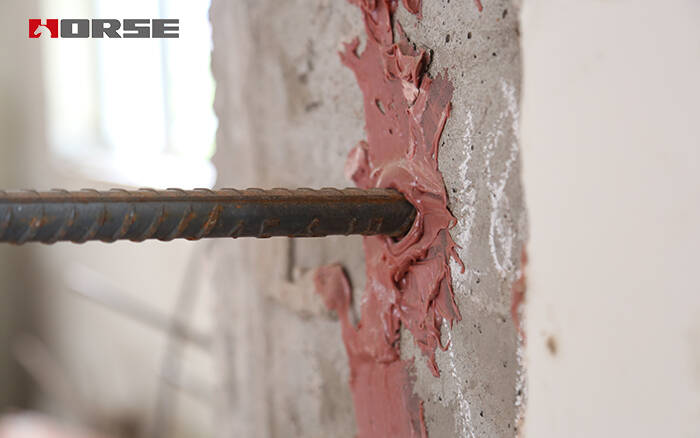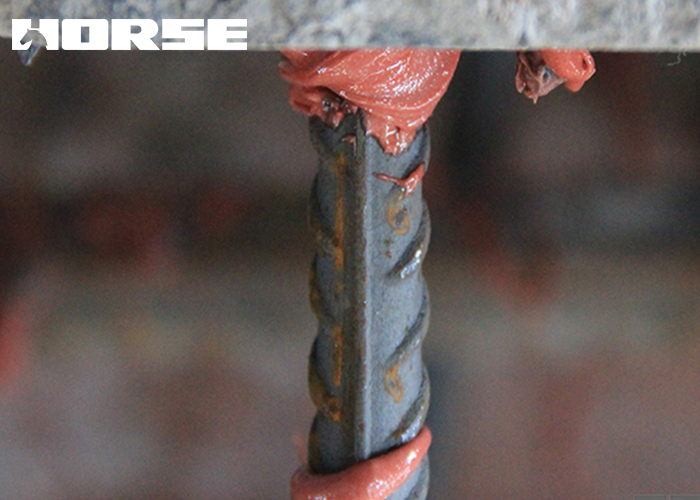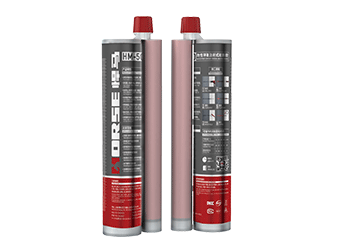Solutions
Horse Construction offers full range of structural strengthening materials with technical supports, documentation supports, products supports, project supports.
The Reinforcement Effect Of Planting Bars Is Not Good?

Planting reinforcement is a simple and effective connection and anchoring technology for concrete structures. It can be implanted with ordinary steel bars or bolt-type anchors. It has been widely used in building reinforcement and reconstruction projects.
During the reinforcement process of planting bars, some factors will disturb the effect of planting reinforcement. If there is a problem, we can consider from the following angles and give corresponding solutions.
Four factors affecting the reinforcement of planting bars: drill hole diameter, steel bar diameter, planting bar spacing, planting bar depth
Drill hole diameter
The percussion drill should be perpendicular to the surface of the concrete when drilling, and the hole diameter size error should be between +2~+6mm. Drill holes must be cleaned to ensure that the holes are dust-free, dry, and the depth and diameter of the holes meet the design requirements before proceeding to the next process. When constructing in a humid environment or below the groundwater level, make sure that the drill hole is dry when planting the reinforcement and injecting the glue.
The bonding between the steel bar and the base material mainly depends on the bonding force of the planting glue. Therefore, when selecting the hole diameter, the hole diameter of the planting bar should be slightly larger than the diameter of the steel bar, so as to ensure that the planting bar glue has a certain thickness to provide sufficient bonding force. The increase of the pore diameter has the effect of increasing the pullout resistance of the implanted bar within a certain range.
The "Code for Acceptance of Construction Quality of Building Structure Reinforcement Engineering" GB50550-2010 puts forward the requirements for the drill hole of the planting bar, and the deviation of the hole diameter of the planting bar should meet the requirements in the table:
The allowable deviation of the drill hole diameter of the implanted reinforcement is determined on the basis of the maximum diameter of the drill bit. Because this diameter is of reference value for the formulation of allowable deviations, it is also convenient to review the relevant parameters of the design. At the same time, engineering practice shows that as long as the quality qualified drill bit is used, the general hole diameter deviation can be controlled within the allowable range.
The allowable deviation of the drill hole diameter of the implanted reinforcement is determined on the basis of the maximum diameter of the drill bit. Because this diameter is of reference value for the formulation of allowable deviations, it is also convenient to review the relevant parameters of the design. At the same time, engineering practice shows that as long as the quality qualified drill bit is used, the general hole diameter deviation can be controlled within the allowable range.
The regulations on the allowable deviation of the verticality of the aperture are formulated with reference to the construction experience at home and abroad. Take the drilling of the upper structural member as an example. Basically, the inclination is taken to be 1.8 for control. This is suitable for steel bars of general length, but in some cases it may be tight.
For this reason, when the verticality deviation of the borehole is large, whether the hole is usable should be confirmed by the design unit. This also means that the allowable deviation value is adjusted according to the actual degree of control required by the project.
In actual engineering, due to the smaller elastic modulus of the binder, the increase of the pore size will cause the slippage of the structural system to increase. This will not only increase the amount of rebar bonding agent and the difficulty of drilling, but also excessively large drilling will significantly reduce the strength of the original structure and cause greater damage.
Therefore, considering the creep of the planting adhesive under the long-term load, the difficulty of planting the construction and the economic efficiency and many other factors, combined with the numerical simulation study, it is considered as follows. Generally, the drill hole diameter D is the steel bar diameter (d+2) mm~(d+10) mm.

Rebar diameter
The diameter of the steel bar is the main factor that determines the number of rebars. The diameter of the steel bars to be selected should be determined according to the actual situation.
In the "Code for Design of Reinforcement of Concrete Structures" GB 50367, the formula for the design value of the axial tensile bearing capacity of a single steel bar can be preliminarily found: the larger A is, the n can be reduced accordingly. A smaller number of implanted bars can reduce the damage to the original structure, but the corresponding hole diameter will also become larger.
When selecting the diameter of the steel bar, the model cannot be determined at will, and it should be determined in combination with the diameter of the drilled hole of the planting bar. For structural planting bars, the steel bar diameter should generally not be greater than 32mm, and n in the formula represents the minimum number of planting bars required. However, due to the shear requirements of steel bars and safety considerations, n will generally increase significantly. The allowable deviation of the diameter of the steel bars should meet the requirements of the following table:
Planting bar spacing
The influence of steel bar spacing on the effect of planting bars is mainly reflected in the distance between the steel bars and the distance between the steel bars and the edge of the base material.
1) The distance between the two steel bars is too close to reduce the overall pull-out resistance of the planting bars.
For multiple implanted bars, due to the close spacing, the range of resistance between the implanted ribs and the implanted ribs will overlap, so that the pullout resistance of each single implanted bar cannot be fully exerted. Therefore, during the design and construction of planting bars, try to ensure that the planting bar spacing is greater than 10d.
Under special circumstances, it is also necessary to ensure that the spacing between the implanted bars is at least 4 d, otherwise not only will the increased resistance of the implanted bars be basically not improved, but also unnecessary damage to the structure due to more drilling. When the planting bar spacing is between 2d and 10d, it should be multiplied by a reduction factor of 50%-90% to ensure that the total pullout resistance meets the requirements.
2) The steel bar is too close to the edge of the base material, which will affect the performance of the original structure to a certain extent.
If the thickness of the protective layer in the original base material is too small, during drilling or for compression members, the members may be split due to large shear forces. Therefore, the thickness of the protective layer should not be less than 5d. The greater the thickness of the protective layer, the better.
But for the original base material, the thicker the protective layer, the better the bonding and anchoring performance, durability and fire resistance of the stressed steel bar, but the greater the width of the cracks generated after the component is stressed. It will affect its performance. In addition, the thickness of the protective layer will affect the layout of the planting bars, resulting in a reduction in the spacing between the planting bars, which in turn affects the effect of the planting bars.
Therefore, the thickness of the protective layer of the reinforcing bar of the base material in the structural reinforcement should preferably not be greater than 15d.
Depth of Reinforcing Bar
The pull-out force of the steel bar is mainly provided by the bonding force between the steel bar and the bonding glue and the bonding force between the concrete and the bonding glue. Therefore, the depth of the planting bar directly determines the pull-out force and the failure form of the planting bar.
Before the construction of bar planting, determining the drilling depth of planting bar is a very important link, which can be specifically considered from the following aspects:
1. The strength of the planting bar glue itself;
2. The strength of concrete;
3. The seismic capacity of the node;
4. The durability of concrete and planting rubber.
In order to make the structure safe, it is necessary to ensure that the failure form is cone-bonding composite failure, that is, the steel bar and the base material slip, resulting in pull-out failure of the mixed interface, and the planted bar yields. It can give full play to the tensile strength of steel bars without brittle failure.
You can find anything here you are in need of, have a trust trying on these products, you will find the big difference after that.

two-components modified epoxy resin adhesive, with high quality plastic tube, double cartridge package

High-strength anchor bolt with vinyl resin as main materials, composed of selected quartz sands, curing agents and glass tubes

Two-components modified epoxy resin adhesive, with high quality plastic tube, double cartridge package for anchoring